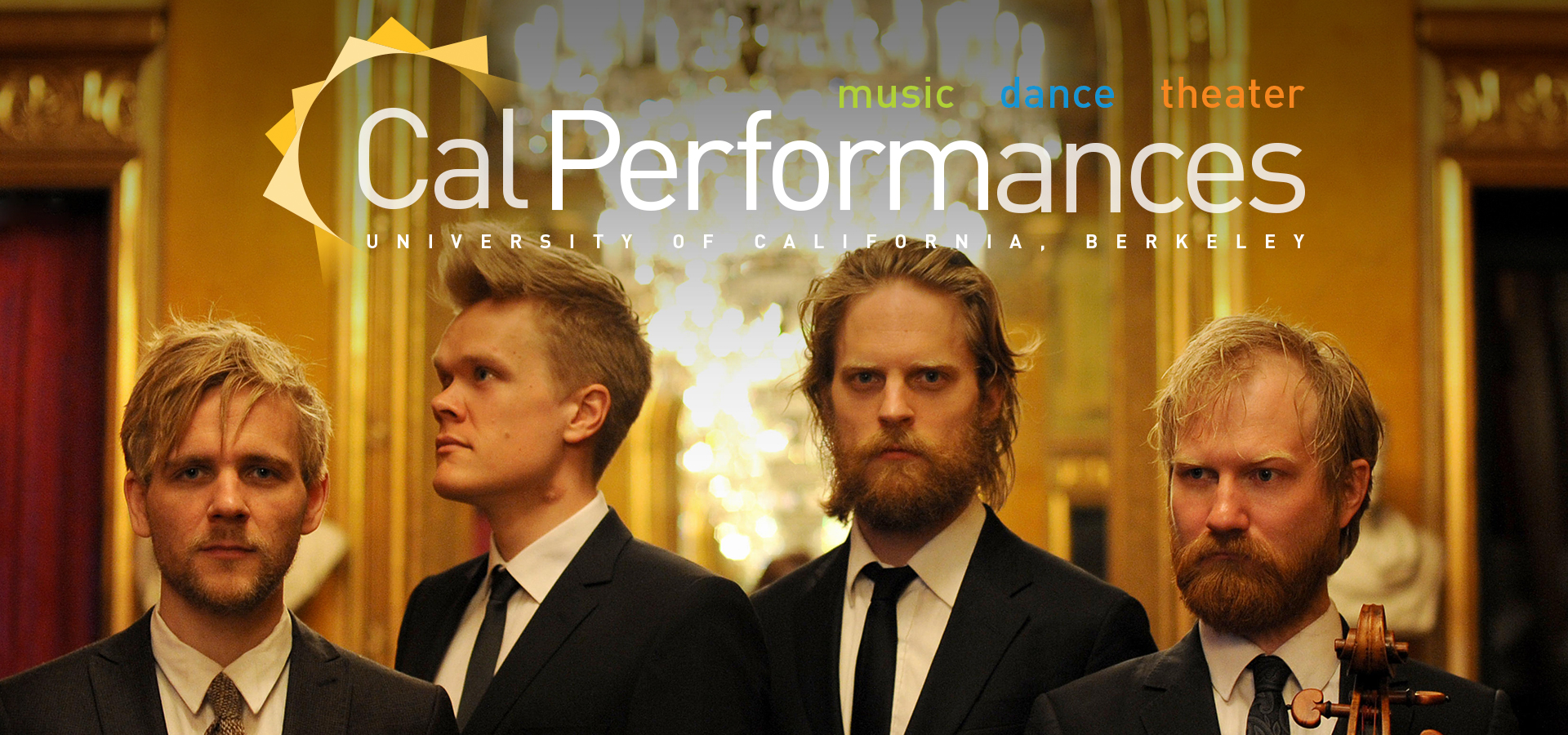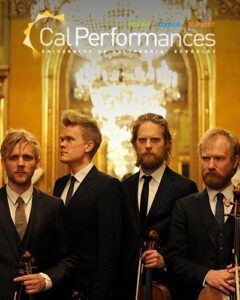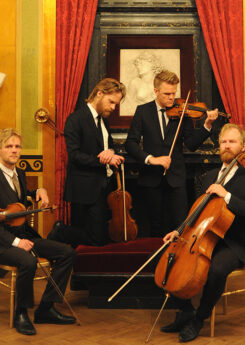Danish String Quartet
Frederik Øland, violin
Rune Tonsgaard Sørensen, violin
Asbjørn Nørgaard, viola
Fredrik Schøyen Sjölin, cello
Friday, April 29, 2022, 8pm
Zellerbach Hall
The Danish String Quartet has recorded for ECM, DaCapo, and CAvi-Music/BR Klassik.
Major support provided by The Bernard Osher Foundation.
This performance will last approximately 90 minutes, including intermission.
From the Executive and Artistic Director

As many of you already know, last week, Cal Performances announced details of its upcoming 2022–23 season. Beginning in September, with the brilliant Miami City Ballet and its legendary production of George Balanchine’s iconic Jewels (1967), and continuing into June 2023, when the ever-popular Eifman Ballet arrives at Zellerbach Hall with its lavish, fully staged Russian Hamlet, it’s a schedule packed with extraordinary opportunities to experience the very best in live music, dance, and theater.
And what a schedule! More than 70 events, with highlights including the return of the legendary Vienna Philharmonic Orchestra, under conductor Christian Thielemann; the beloved Mark Morris Dance Group in Morris’ new The Look of Love: An Evening of Dance to the Music of Burt Bacharach; revered South African artist William Kentridge’s astonishing new SIBYL; a rare Berkeley performance with the San Francisco Symphony and conductor Esa-Pekka Salonen; and a special concert with chamber music superstars pianist Emanuel Ax, violinist Leonidas Kavakos, and cellist Yo-Ma. And these are only a few of the amazing performances that await you!
Illuminations programming next season will take advantage of Cal Performances’ unique positioning as both a renowned international performing arts presenter and a part of one of the world’s top-ranked public research universities. Each season, Illuminations takes up a pressing theme reflected in both the arts and scholarship, and offers the public a multifaceted understanding of the issue by connecting research on the UC Berkeley campus with exceptional performances. This third season of Illuminations centers on the theme of “Human and Machine,” investigating how technology continues to catalyze and challenge creative expression and human communication. Through programming that includes performances, public events, artist talks, and symposia, we’ll be engaging communities on and off campus to examine the evolution of musical instruments, the complex relationships between technology creators and users, technology’s impact on the creative process, and questions raised by the growing role of artificial intelligence in our society.
This concept of “Human and Machine” has never been so pertinent to so many. Particularly over the course of the pandemic, the rapid expansion of technology’s role in improving communication and in helping us emotionally process unforeseen and, at times, extraordinarily difficult events has made a permanent mark on our human history. Throughout time, our reliance on technology to communicate has—for better or worse—influenced how we understand others as well as ourselves. During this Illuminations season, we will investigate how technology has contributed to our capacity for self-expression, as well as the potential dangers it may pose.
Some programs this season will bring joy and delight, and others will inspire reflection and stir debate. We are committed to presenting this wide range of artistic expression on our stages because or our faith in the performing arts’ unparalleled power to promote empathy. And it is because of our audiences’ openness and curiosity that we have the privilege of bringing such thought-provoking, adventurous performances to our campus. The Cal Performances community wants the arts to engage in important conversations, and to bring us all together as we see and feel the world through the experiences of others.
Please make sure to check out our brand new 44-page season brochure and our website for complete information. We can’t wait to share all the details with you, in print and online!
Finally, thank you for joining us for today’s concert. It’s great that we’re all back together again, enjoying the pleasures and rewards of live performance.
Jeremy Geffen
Executive and Artistic Director, Cal Performances
 As many of you already know, last week, Cal Performances announced details of its upcoming 2022–23 season. Beginning in September, with the brilliant Miami City Ballet and its legendary production of George Balanchine’s iconic Jewels (1967), and continuing into June 2023, when the ever-popular Eifman Ballet arrives at Zellerbach Hall with its lavish, fully staged Russian Hamlet, it’s a schedule packed with extraordinary opportunities to experience the very best in live music, dance, and theater.
As many of you already know, last week, Cal Performances announced details of its upcoming 2022–23 season. Beginning in September, with the brilliant Miami City Ballet and its legendary production of George Balanchine’s iconic Jewels (1967), and continuing into June 2023, when the ever-popular Eifman Ballet arrives at Zellerbach Hall with its lavish, fully staged Russian Hamlet, it’s a schedule packed with extraordinary opportunities to experience the very best in live music, dance, and theater.
And what a schedule! More than 70 events, with highlights including the return of the legendary Vienna Philharmonic Orchestra, under conductor Christian Thielemann; the beloved Mark Morris Dance Group in Morris’ new The Look of Love: An Evening of Dance to the Music of Burt Bacharach; revered South African artist William Kentridge’s astonishing new SIBYL; a rare Berkeley performance with the San Francisco Symphony and conductor Esa-Pekka Salonen; and a special concert with chamber music superstars pianist Emanuel Ax, violinist Leonidas Kavakos, and cellist Yo-Ma. And these are only a few of the amazing performances that await you!
Illuminations programming next season will take advantage of Cal Performances’ unique positioning as both a renowned international performing arts presenter and a part of one of the world’s top-ranked public research universities. Each season, Illuminations takes up a pressing theme reflected in both the arts and scholarship, and offers the public a multifaceted understanding of the issue by connecting research on the UC Berkeley campus with exceptional performances. This third season of Illuminations centers on the theme of “Human and Machine,” investigating how technology continues to catalyze and challenge creative expression and human communication. Through programming that includes performances, public events, artist talks, and symposia, we’ll be engaging communities on and off campus to examine the evolution of musical instruments, the complex relationships between technology creators and users, technology’s impact on the creative process, and questions raised by the growing role of artificial intelligence in our society.
This concept of “Human and Machine” has never been so pertinent to so many. Particularly over the course of the pandemic, the rapid expansion of technology’s role in improving communication and in helping us emotionally process unforeseen and, at times, extraordinarily difficult events has made a permanent mark on our human history. Throughout time, our reliance on technology to communicate has—for better or worse—influenced how we understand others as well as ourselves. During this Illuminations season, we will investigate how technology has contributed to our capacity for self-expression, as well as the potential dangers it may pose.
Some programs this season will bring joy and delight, and others will inspire reflection and stir debate. We are committed to presenting this wide range of artistic expression on our stages because or our faith in the performing arts’ unparalleled power to promote empathy. And it is because of our audiences’ openness and curiosity that we have the privilege of bringing such thought-provoking, adventurous performances to our campus. The Cal Performances community wants the arts to engage in important conversations, and to bring us all together as we see and feel the world through the experiences of others.
Please make sure to check out our brand new 44-page season brochure and our website for complete information. We can’t wait to share all the details with you, in print and online!
Finally, thank you for joining us for today’s concert. It’s great that we’re all back together again, enjoying the pleasures and rewards of live performance.
Jeremy Geffen
Executive and Artistic Director, Cal Performances





